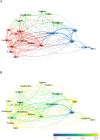Two decades of progress in gastric cancer peritoneal metastasis: a bibliometric perspective on molecular mechanisms and therapeutic innovations
- PMID: 40519309
- PMCID: PMC12162253
- DOI: 10.3389/fonc.2025.1583364
Two decades of progress in gastric cancer peritoneal metastasis: a bibliometric perspective on molecular mechanisms and therapeutic innovations
Abstract
Background: Gastric cancer (GC) is the fifth most common malignant tumor worldwide. The peritoneum is a common site of metastasis in advanced GC, and patients with gastric cancer peritoneal metastasis (GCPM) have a very low 5-year survival rate. Systemic therapy has limited efficacy for peritoneal metastases, and early diagnosis is difficult. In this paper, we analyzed the GCPM-related literature by bibliometric methods, aiming to identify the research hotspots and trends and to provide a basis for clinical practice and research planning.
Methods: Based on the Web of Science Core Collection database (WoSCC), we screened the GCPM-related literature published from 2004 to 2024. Countries, institutions, authors, journals, and keywords were analyzed and visualized by tools such as CiteSpace, VOSviewer, Scimago Graphica, RStudio, and the Bibliometrix package.
Result: A total of 2416 publications were included in this study. The growth rate of GCPM publications is positive until 2021, with a slowdown in the near future. Japan dominated the research output (842 publications), followed by China (748 publications) and the United States (268 publications). Japanese-affiliated organizations and researchers are extremely productive in the field of GCPM. The most frequently cited document was Japanese gastric cancer treatment guidelines 2014 (ver. 4) (citations = 2076). Research focuses on four major clusters: (1) molecular mechanisms of GCPM; (2) prognosis of GCPM; (3) chemotherapy of GCPM; and (4) intraperitoneal treatment of GCPM. Emerging trends include key pathways of GCPM, artificial intelligence (AI) and multi-omics-driven early diagnosis, novel intraperitoneal therapeutic modalities, and immunologic/targeted drugs.
Conclusion: Japan is a leader in GCPM research. Recently, the focus of GCPM research has shifted from basic treatment to precision and personalized treatment through the integration of molecular mechanisms, novel intraperitoneal therapeutic modalities, and AI technologies. Current challenges include the lack of standardized validation systems for emerging technologies and regional differences in clinical practice. In the future, there is a need to promote global collaborative trials and optimization of multimodality therapy. The results of this study provide a key direction and systematic basis for future exploration of GCPM.
Keywords: bibliometric; gastric cancer; intraperitoneal treatment; molecular mechanisms; peritoneal metastasis.
Copyright © 2025 Qian, Tu, Chen, Chen, Zhou, Sun and Wu.
Conflict of interest statement
The authors declare that the research was conducted in the absence of any commercial or financial relationships that could be construed as a potential conflict of interest.
Figures















Similar articles
-
Gastric cancer peritoneal metastasis: a bibliometric study from 2000 to 2024 using VOSviewer software.Front Oncol. 2025 Mar 4;15:1489043. doi: 10.3389/fonc.2025.1489043. eCollection 2025. Front Oncol. 2025. PMID: 40104504 Free PMC article. Review.
-
Research trends in endoscopic applications in early gastric cancer: A bibliometric analysis of studies published from 2012 to 2022.Front Oncol. 2023 Apr 11;13:1124498. doi: 10.3389/fonc.2023.1124498. eCollection 2023. Front Oncol. 2023. PMID: 37114137 Free PMC article. Review.
-
Tracing global progress: two decades of age-related macular degeneration research.Int J Ophthalmol. 2025 May 18;18(5):925-936. doi: 10.18240/ijo.2025.05.20. eCollection 2025. Int J Ophthalmol. 2025. PMID: 40385108 Free PMC article.
-
Bibliometric analysis of bone metastases from lung cancer research from 2004 to 2023.Front Oncol. 2024 Aug 6;14:1439209. doi: 10.3389/fonc.2024.1439209. eCollection 2024. Front Oncol. 2024. PMID: 39165682 Free PMC article.
-
Advances and global trends of precancerous lesions of gastric cancer: A bibliometric analysis.World J Gastrointest Oncol. 2025 Mar 15;17(3):102111. doi: 10.4251/wjgo.v17.i3.102111. World J Gastrointest Oncol. 2025. PMID: 40092937 Free PMC article.
References
Publication types
LinkOut - more resources
Full Text Sources
Miscellaneous

